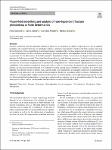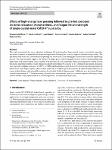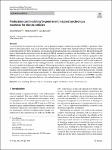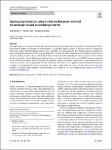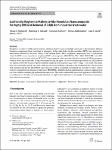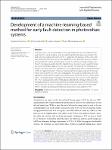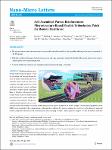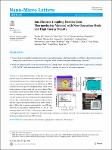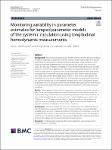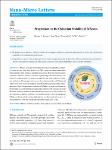Search
Author
- Osman, Ahmed I. (5)
- Daqing, Ma (3)
- Jorgensen, Ed (3)
- Li, Yan (3)
- next >
Subject
- kinh tế (26)
- Economics (12)
- programming (10)
- XRD (10)
- next >
Date issued
- 2020 - 2025 (2128)
- 2010 - 2019 (129)
- 2000 - 2009 (9)
- 1999 - 1999 (1)
Has File(s)
Search Results
Fracture of materials with rate-dependent mechanical behaviour, e.g. polymers, is a highly complex process. For an adequate modelling, the coupling between rate-dependent stiffness, dissipative mechanisms present in the bulk material and crack driving force has to be accounted for in an appropriate manner. In addition, the resistance against crack propagation can depend on rate of deformation. In this contribution, an energetic phase-field model of rate-dependent fracture at finite deformation is presented. For the deformation of the bulk material, a formulation of finite viscoelasticity is adopted with strain energy densities of Ogden type assumed. The unified formulation allows to study different expressions for the fracture driving force. Furthermore, a possibly rate-dependent to... |
This study investigated the stress relaxation and fatigue life and strength of laser-peened single-crystal nickel superalloy specimens compared to unpeened and shot-peened specimens following hot corrosion exposure and then fatigue testing. The specimens were treated by conventional laser peening and a new cyclic laser peening plus thermal microstructure engineering process. The latter treatment supports the benefit of a unique process involving application of layers of laser peening using high energy with large footprint spots combined with interspersed cyclic annealing. Stress measurements by slitting showed the plastic penetration depth of laser peening exceeded shot peening by a factor of 24. |
A cost model for the estimation of production costs of permanent magnet synchronous machines (PMSM) is presented, which allows to alter design choices such as wire technology, winding layout, cooling system, materials and more. With the goal to make results reproducible by others, the methods are explained in detail and used data and assumptions are given. The developed model helps to understand the interaction between the design of PMSM, manufacturing methods and the resulting costs. With it, different PMSM technologies and materials can be evaluated regarding its influence on the production costs, which is a perquisite to find the best compromise between performance and costs. Production volume is shown to be the most decisive factor for the resulting production costs. |
This paper proposes a density-based topology optimization method for natural convection problems using the lattice Boltzmann method (LBM). As the LBM can be developed as a completely explicit scheme, its attractive features over the traditional ones, such as the finite element method, are (1) suitability for solving unsteady flow problems and (2) scalability for large-scale parallel computing. We develop an LBM code for solving unsteady natural convection problems and provide its sensitivity analysis based on the so-called adjoint lattice Boltzmann method. Notably, the adjoint equation is derived from the discrete particle velocity Boltzmann equation and can be solved similarly to the original LBM concerning unsteady natural convection problems. |
Kaolinite is a widely available and inexpensive substance that has been successfully employed to decontaminate different hazardous contaminants from wastewater by adsorption. In this study, halloysite-like nanotubes (HNTs) were prepared via intercalation followed by ultrasonic rolling of the kaolinite layers. Then, maghemite nanoparticles were co-precipitated within the HNTs matrix to produce a maghemite/HNTs nanocomposite (MG@HNTs). XRD, SEM, TEM, FTIR, and a BET analyzer were used to characterize the MG@HNTs nanocomposite, which was then utilized to eliminate Cd(II) from aqueous solutions (water and wastewater). Using a batch methodology, the impact of various adsorption parameters on Cd(II) removal was explored. MG@HNTs nanocomposite exhibited a high adsorption capacity (qe) of 2... |
In the process of the decarbonization of energy production, the use of photovoltaic systems (PVS) is an increasing trend. In order to optimize the power generation, the fault detection and identification in PVS is significant. The purpose of this work is the study and implementation of such an algorithm, for the detection as many as faults arising on the DC side of a photovoltaic system. A machine learning technique was chosen. The dataset used to train the algorithm was based on a year’s worth of irradiance and temperature data, as well as data from the PV cell used. The method uses logistic regression with cross validation as a new approach to detect and identify faults in PVS. |
Realizing real-time monitoring of physiological signals is vital for preventing and treating chronic diseases in elderly individuals. However, wearable sensors with low power consumption and high sensitivity to both weak physiological signals and large mechanical stimuli remain challenges. Here, a flexible triboelectric patch (FTEP) based on porous-reinforcement microstructures for remote health monitoring has been reported. The porous-reinforcement microstructure is constructed by the self-assembly of silicone rubber adhering to the porous framework of the PU sponge. The mechanical properties of the FTEP can be regulated by the concentrations of silicone rubber dilution. |
Ionic thermoelectrics (i-TE) possesses great potential in powering distributed electronics because it can generate thermopower up to tens of millivolts per Kelvin. However, as ions cannot enter external circuit, the utilization of i-TE is currently based on capacitive charge/discharge, which results in discontinuous working mode and low energy density. Here, we introduce an ion–electron thermoelectric synergistic (IETS) effect by utilizing an ion–electron conductor. Electrons/holes can drift under the electric field generated by thermodiffusion of ions, thus converting the ionic current into electrical current that can pass through the external circuit. |
Physics-based cardiovascular models are only recently being considered for disease diagnosis or prognosis in clinical settings. These models depend on parameters representing the physical and physiological properties of the modeled system. Personalizing these parameters may give insight into the specific state of the individual and etiology of disease. We applied a relatively fast model optimization scheme based on common local optimization methods to two model formulations of the left ventricle and systemic circulation. One closed-loop model and one open-loop model were applied. Intermittently collected hemodynamic data from an exercise motivation study were used to personalize these models for data from 25 participants. The hemodynamic data were collected for each participant at t... |
MXenes are under the spotlight due to their versatile physicochemical characteristics. Since their discovery in 2011, significant advancements have been achieved in their synthesis and application sectors. However, the spontaneous oxidation of MXenes, which is critical to its processing and product lifespan, has gotten less attention due to its chemical complexity and poorly understood oxidation mechanism. This perspective focuses on the oxidation stability of MXenes and addresses the most recent advancements in understanding and the possible countermeasures to limit the spontaneous oxidation of MXenes |

